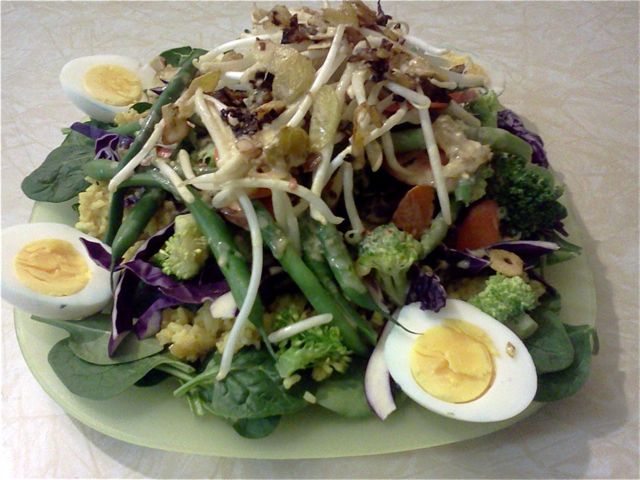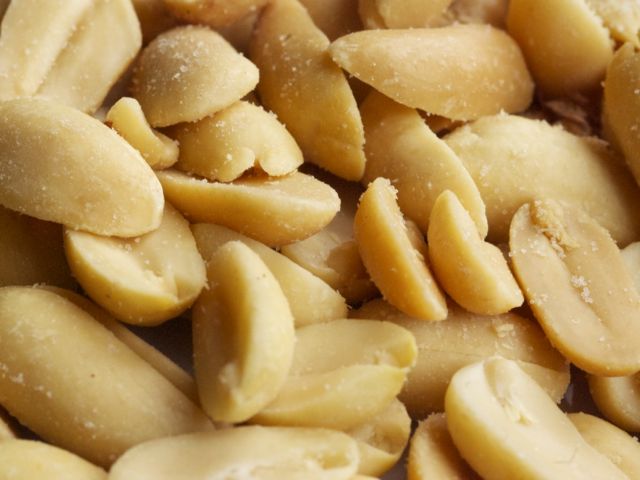
gadogado, l
(article, Shoshanna Cohen)
[%pageBreakSettings nobreak=true] Peanuts are a citizen of the world. I can’t think of anything else that is a comfort-food staple in as many different places, in as many different forms. Here in the U.S., we have peanut-butter sandwiches. Other countries have stews, salads, curries, and candies. Peanuts intrigue me. Their strong, distinctive flavor shows up in many wild dishes, yet they're also somehow kid food. Super-picky kids who won’t eat anything strong or spicy still love peanut butter. Which blows my mind, because while I, too, love the stuff, I find it really potent. If I haven’t had any for a while and someone nearby takes the lid off a jar of Skippy, it nearly knocks me off my feet. [%image reference-image float=right width=400 caption="Nuts about peanuts."] Peanuts were not always such a pervasive part of the American diet. According to the National Peanut Board (which is perhaps partly responsible for maintaining such pervasiveness), they were grown here during the 19th century, but were considered poor people’s food. A string of events elevated the peanut’s profile: Civil War soldiers who had eaten them out of necessity developed a taste for them; people invented farming equipment that made growing them easier; and George Washington Carver began pioneering uses for the little guys and promoting them as a cash crop and a good thing to eat. Peanuts and peanut butter caught on big time, and now it seems the only American households without a sticky jar in the kitchen are those where someone is, tragically, allergic. Interestingly, in the United States peanut butter's applications remain on the sweet to neutral side, typically smooshed between two pieces of bread, combined with chocolate in any way possible, or (so I have heard) eaten by the spoonful out of the jar. But the American peanut experience is just part of the peanut plant's long history. Again from the National Peanut Board, peanuts (which are technically a legume, not a nut) originated in South America, and during the Age of Exploitation — er, I mean, Exploration — European traders knew a good thing when they saw it, spreading peanut butter across the globe. So we can thank them at least for that. Peanuts have become common in West Africa, where they grow easily and are both a cash crop and a regional staple, eaten not in sandwiches but in meat stews, sauces, and sweets. Back at home in Peru, peanuts appear in sauces smothering meat or potatoes, as well as in the tombs of the mummified dead, where [%amazonProductLink asin=076411258 "Barron’s Food Lover’s Companion" newpage=true] reports they were placed by ancient Peruvians for nourishment on the long road to the afterlife. The Peruvian food blog Canela and Comino explains a dish called Patita con Mani, or “Foot with Peanuts,” made with cow or pig’s feet. Another common Peruvian dish, Ocopa Arequipena, slathers potatoes in a slime-green peanut-herb sauce. I thought it was weird that the first Ocopa Arequipena recipe I found called for pulverizing peanuts in a blender with chiles, herbs, evaporated milk, and graham crackers, but I kept looking, and apparently that’s pretty standard. This is an enigma that will require further research. Peanuts also show up frequently in Southeast Asian cooking, in curries, sauces, salads, and stir-fries. They absolutely shine in Thai food. I love a good Massaman curry with juicy peanuts, coconut milk, and tamarind. As a kid, the only thing I would eat from a Thai restaurant was chicken satay with sweet, velvety peanut sauce, and it’s still one of my favorites. Over in Indonesia, peanuts are an important part of gado gado, aptly defined by cookbook author Mollie Katzen as “an Indonesian extravaganza.” To call gado gado a mere salad would be to miss its brilliance. Not only does this vegetable concoction have a fun name, it has about 25 brightly colored ingredients and is doused in peanut sauce, which is a nice way to eat your greens. Typical elements include rice (often cooked with curry or coconut), a pile of veggies, and little crispy fried bits of garlic and ginger, all bathed in a light peanut dressing. Gado gado can be as elaborate as you like. “It’s all a matter of presentation,” says Pete Rubijono, a friend of mine with Indonesian heritage. For a special event like a wedding, Pete tells me, the salad’s ingredients are formed into a beautiful wedding cake-like pyramid. You can also just pile it all on a plate if you’re feeling lazy, but honestly, if you’re feeling lazy, you probably shouldn’t attempt this dish from scratch in the first place. To someone whose typical mode of cooking amounts to coarsely chopping some veggies, butterflying a sausage, and sticking everything in the oven for 20 minutes, gado gado seems outrageously, gratuitously complicated, especially for what amounts to a pile of steamed vegetables. This is something to make with a few friends when dinner is mostly an excuse to hang out all night. Assign one person the veggies, one person the toppings, and another person the sauce, eggs, and rice. Supply a six-pack and something to snack on while the meal is coming together so nobody gets cranky. [%image gadogado float=right width=400 caption="Gado gado, à la Mollie Katzen."] The end result is well worth the effort. I am typically not that enthused about salads, but gado gado is surprisingly satisfying and intriguing to me — and a heck of a lot more enticing than a straight-up pile of steamed vegetables. The eggs, rice, and oily fried toppings make it a hearty, filling meal, while the crisp veggies keep it fresh-tasting and virtuous-feeling. The spicy peanut sauce ties it all together. I am drawn to this dish in the middle of winter, when the holiday season and January flus have done a number on my health and the dim, cold days have done a number on my mood. There's nothing like a bright plate of veggies to turn everything back in the right direction. But the cool, spicy dish would be equally welcome on a muggy summer night. [[block(sidebar). h1.Featured recipe]] Because of peanuts' cross-cultural history, I felt it fitting to include a recipe here for Indonesian salad written by an American: Mollie Katzen, from her vegetarian classic The New Moosewood Cookbook. As with all great comfort foods, Katzen's recipe is made up of familiar, easy-to-find, and easy-to-like ingredients. It's based on something Indonesian, but translated into American. Even so, from what I’ve gathered, it’s not that far from the original. Then again, as a dish with lots of variations made by Indonesians living all over the world, maybe there is no such thing as inauthentic gado gado. Like all of us, the divergent variations have their own unique traits, but are united by a common element: peanut butter, the mortar that binds humanity together.

gadogado, l

reference-image, l